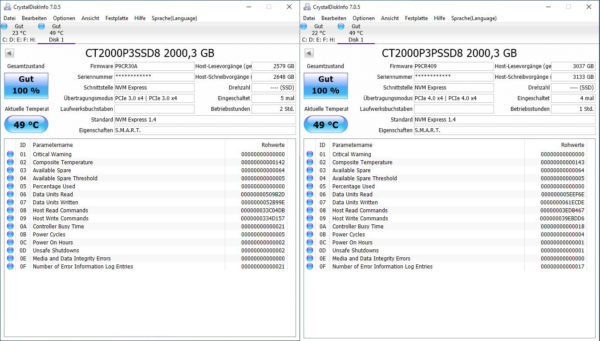
Here are the technical data according to manufacturer …
| Manufacturer | Crucial |
| Article number | CT2000P3PSSD8 / CT2000P3SSD8 |
| Capacity | 2000GB (NAND) |
| Interface | P3: PCIe 3.0 x4 NVMe 1.3 / P3 Plus: PCIe 4.0 x4 NVMe 1.4 (Plus) |
| Cache | – |
| Controller | Phison PS5021-E21 |
| Flash Typ | Micron 176 Layer 3D QLC NAND – Quadruple-Level-Cell |
| Size | M.2 2280 (80 x 22 x 3.5mm) |
| Weight | approx. 10 gram |
| Speed | P3 2TB: Read up to 3500MB/s und write up to 3000MB/s / P3 Plus 2TB: Read up to 5000MB/s und write up to 4200MB/s |
| MTBF | 1,5 million hours, 440 TB total bytes written (TBW), equal to approx. 241 GB per day for 5 years. |
| Miscellaneous | SMART Support – Self-Monitoring and Reporting Technology, TRIM support, RAIN (Redundant Array of Independent NAND), HMB (Host Memory Buffer), Dynamic Write Acceleration, Adaptive Thermal Protection, Active Garbage Collection, Integrated Power Loss Immunity, Multistep Data Integrity Algorithms and Error Correction Code. |
Here is a screenshot of the CrystalDiskInfo SSD and hard drive information software. As with the previous SSDs from Micron and Crucial, respectively, the SSDs were equipped with a temperature sensor that can be queried correctly under Microsoft Windows 10 and Windows 11. Alternatively, you can query the Crucial SSD temperature with the Crucial Storage Executive software. Idle temperatures of over 40°C and load temperatures clearly over 50°C are not uncommon for M.2 SSDs. The two P3 SSDs do extremely well in this discipline, as you can see here in the low temperature even after a few benchmarks. We will go into more detail about the maximum NVMe SSD temperature including thermal images on the Crucial P3 Practical testing page.

Crucial P3 vs Crucial P3 Plus 2TB M.2 NVMe Layout, design and features …

